
DDR SDRAM
DDR SDRAM 256Mb E-die (x4, x8)
Rev. 1.1 September. 2003
256Mb E-die DDR 400 SDRAM Specification
Revision 1.1
60Ball FBGA (x4/x8)

DDR SDRAM
DDR SDRAM 256Mb E-die (x4, x8)
Rev. 1.1 September. 2003
256Mb E-die Revision History
Revision 1.0 (July, 2003)
- First release
Revision 1.1 (September, 2003)
- Modified DDR SDRAM Spec Items & Test Conditions
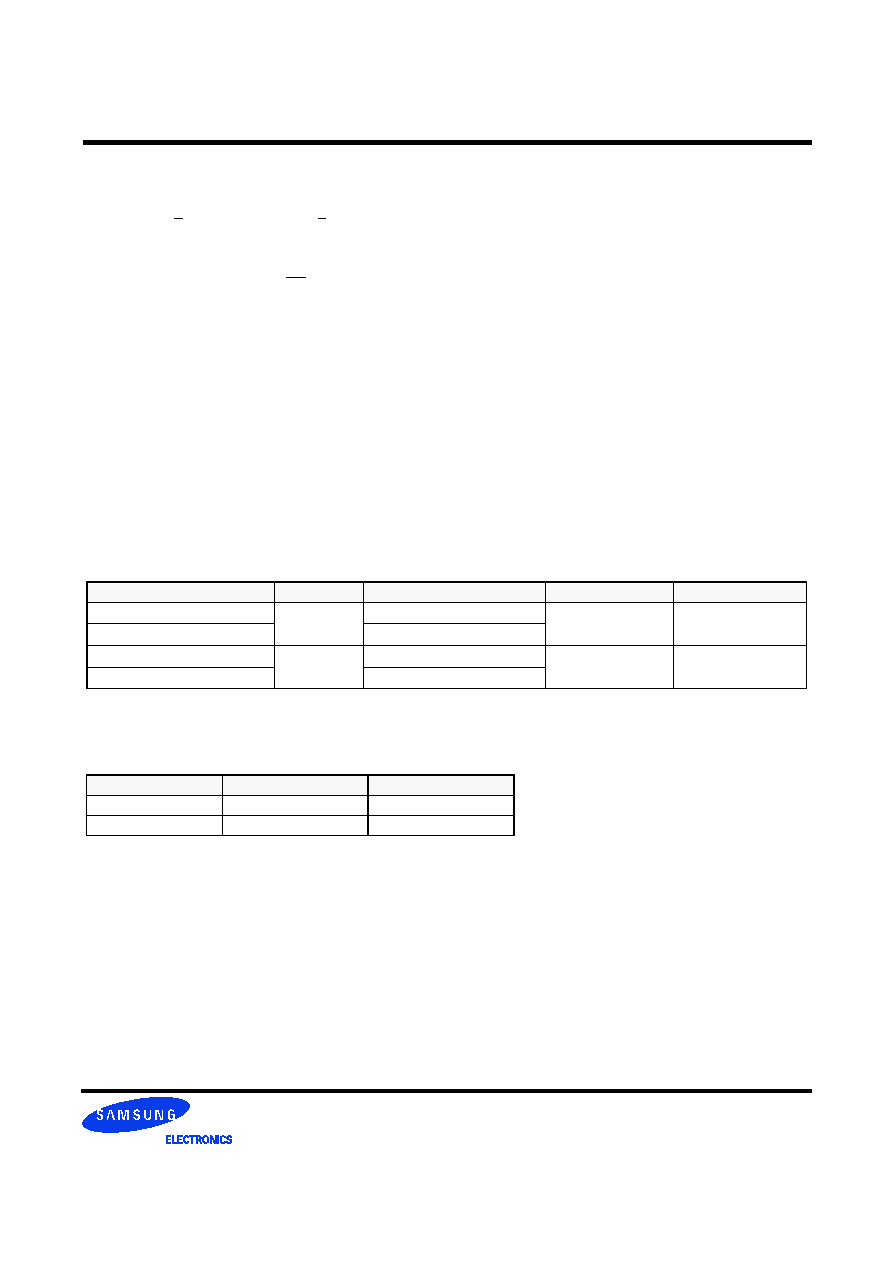
DDR SDRAM
DDR SDRAM 256Mb E-die (x4, x8)
Rev. 1.1 September. 2003
∑ 200MHz Clock, 400Mbps data rate.
∑ VDD= +2.6V + 0.10V, VDDQ= +2.6V + 0.10V
∑ Double-data-rate architecture; two data transfers per clock cycle
∑ Bidirectional data strobe [DQ] (x4,x8)
∑ Four banks operation
∑ Differential clock inputs(CK and CK)
∑ DLL aligns DQ and DQS transition with CK transition
∑ MRS cycle with address key programs
-. Read latency 3 (clock) for DDR400 , 2.5 (clock) for DDR333
-. Burst length (2, 4, 8)
-. Burst type (sequential & interleave)
∑ All inputs except data & DM are sampled at the positive going edge of the system clock(CK)
∑ Data I/O transactions on both edges of data strobe
∑ Edge aligned data output, center aligned data input
∑ DM for write masking only (x4, x8)
∑ Auto & Self refresh
∑ 7.8us refresh interval(8K/64ms refresh)
∑ Maximum burst refresh cycle : 8
∑ 60Ball FBGA package
Key Features
Ordering Information
Part No.
Org.
Max Freq.
Interface
Package
K4H560438E-GCCC
64M x 4
CC(DDR400@CL=3)
SSTL2
60 FBGA
K4H560438E-GCC4
C4(DDR400@CL=3)
K4H560838E-GCCC
32M x 8
CC(DDR400@CL=3)
SSTL2
60 FBGA
K4H560838E-GCC4
C4(DDR400@CL=3)
*CL : CAS Latency
Operating Frequencies
- CC(DDR400@CL=3)
- C4(DDR400@CL=3)
Speed @CL3
200MHz
200MHz
CL-tRCD-tRP
3 - 3 - 3
3 - 4 - 4

DDR SDRAM
DDR SDRAM 256Mb E-die (x4, x8)
Rev. 1.1 September. 2003
Ball Description
DM is internally loaded to match DQ and DQS identically.
Row & Column address configuration
Organization
Row Address
Column Address
64Mx4
A0~A12
A0-A9, A11
32Mx8
A0~A12
A0-A9
1
VSSQ
NC
NC
NC
NC
VREF
2
NC
VDDQ
VSSQ
VDDQ
VSSQ
VSS
CK
A12
A11
A8
A6
A4
3
VSS
DQ3
NC
DQ2
DQS
DM
CK
CKE
A9
A7
A5
VSS
A
B
C
D
E
F
G
H
J
K
L
M
7
VDD
DQ0
NC
DQ1
NC
NC
WE
RAS
BA1
A0
A2
VDD
8
NC
VSSQ
VDDQ
VSSQ
VDDQ
VDD
CAS
CS
BA0
A10/AP
A1
A3
9
VDDQ
NC
NC
NC
NC
NC
1
VSSQ
NC
NC
NC
NC
VREF
2
DQ7
VDDQ
VSSQ
VDDQ
VSSQ
VSS
CK
A12
A11
A8
A6
A4
3
VSS
DQ6
DQ5
DQ4
DQS
DM
CK
CKE
A9
A7
A5
VSS
A
B
C
D
E
F
G
H
J
K
L
M
7
VDD
DQ1
DQ2
DQ3
NC
NC
WE
RAS
BA1
A0
A2
VDD
8
DQ0
VSSQ
VDDQ
VSSQ
VDDQ
VDD
CAS
CS
BA0
A10/AP
A1
A3
9
VDDQ
NC
NC
NC
NC
NC
32M x 8bit
64M x 4bit
(
Bottom View
)
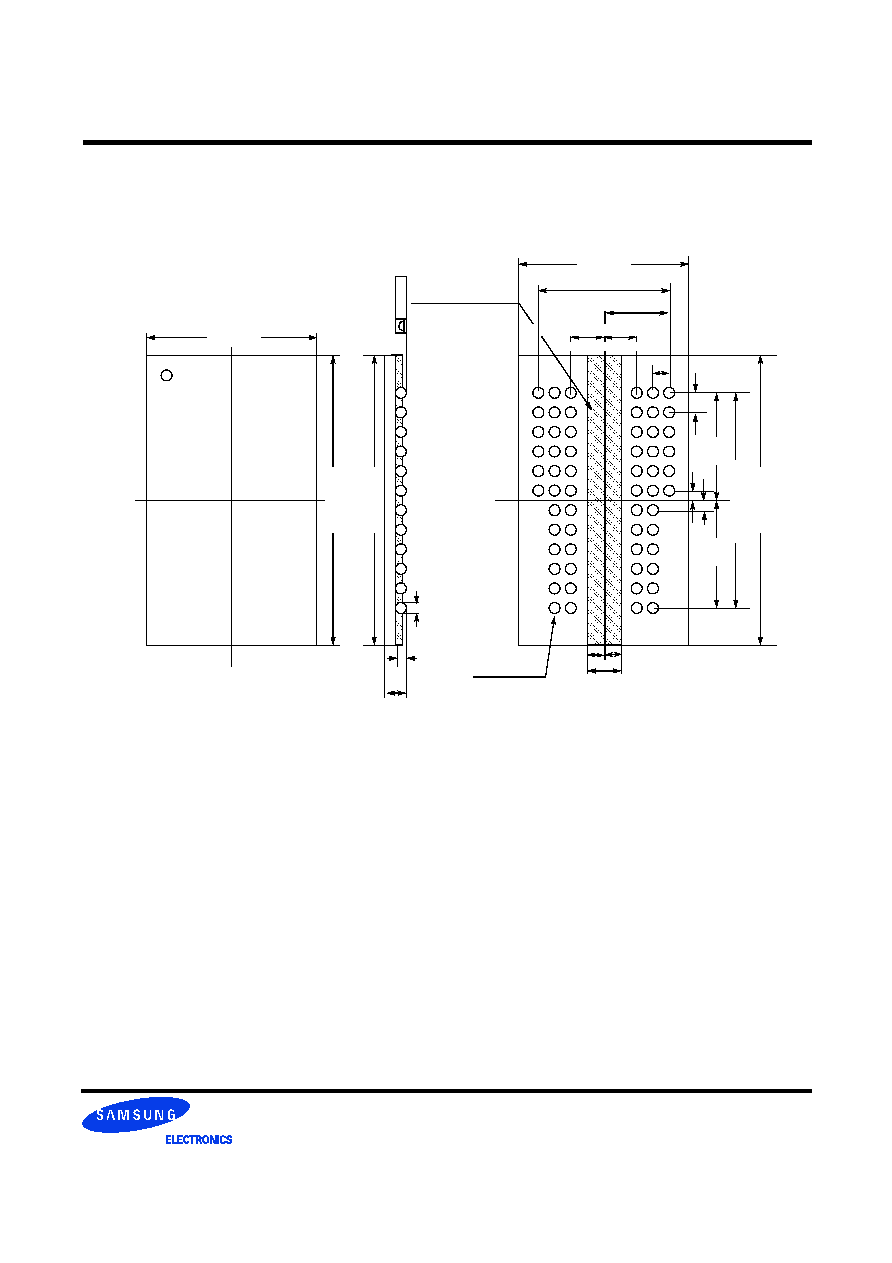
DDR SDRAM
DDR SDRAM 256Mb E-die (x4, x8)
Rev. 1.1 September. 2003
60Ball FBGA Package Dimension
Package Physical Dimension
( Unit : mm )
(0.90)
(0.90)
8.0 0
±
0.10
14.0
0
±
0.10
14.
0
±
0.
10
0
.
10 Max
0.4
5
±
0.0
5
0.35
±
0.05
1.10
±
0.10
1
2
3
4
5
6
7
8
9
ENCAPSULANT AREA
8.00
±
0.10
0.80 x 4 = 3.20
1.60
1.60
A
B
C
D
E
F
G
H
J
K
L
M
0.80
0.50
5.
5
0
1.0
0
x
11 =
11.0
0
14.0
0
±
0.10
5.
5
0
60 - 0.45
±
0.05
0.80 x 8 = 6.40
TOP VIEW
BOTTOM VIEW
(1.80)
0.50
1.00
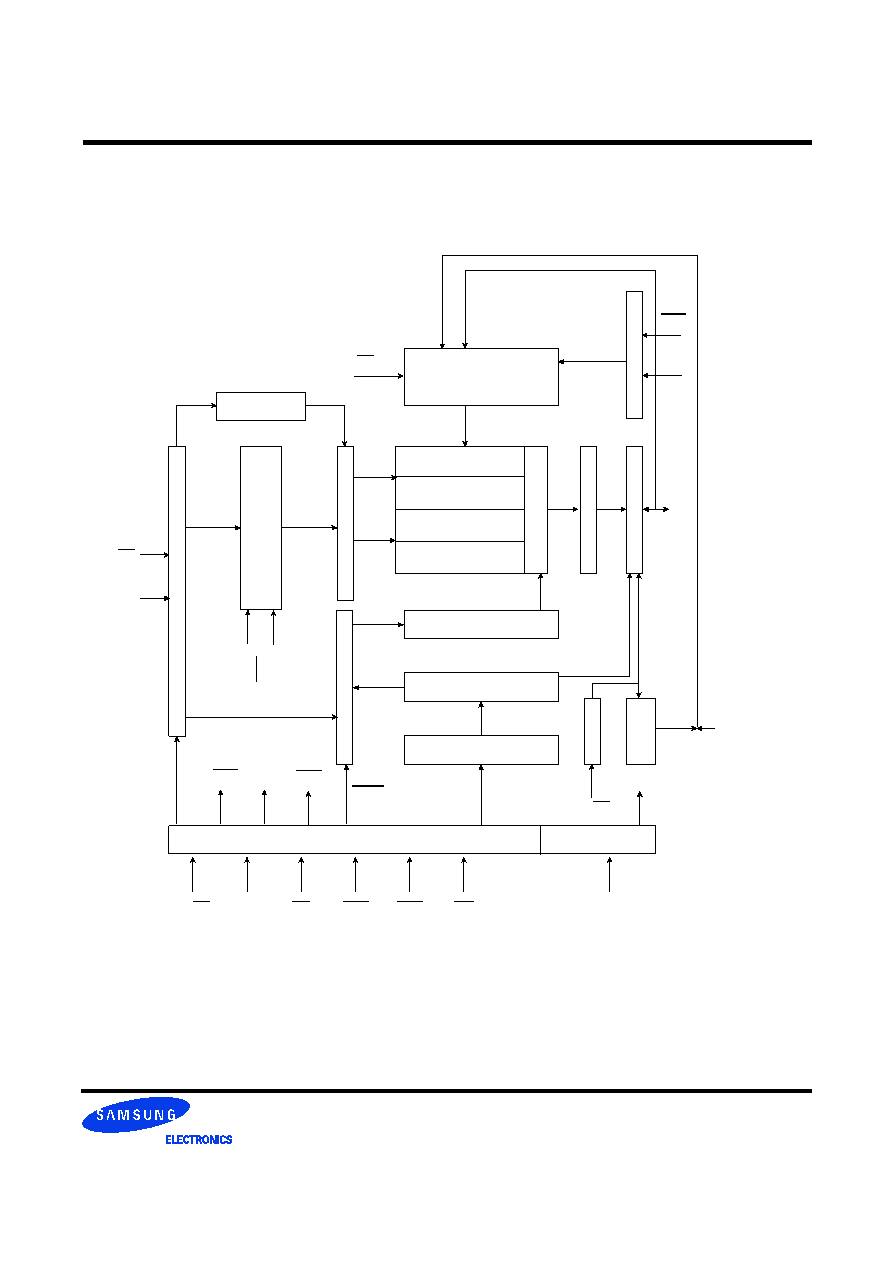
DDR SDRAM
DDR SDRAM 256Mb E-die (x4, x8)
Rev. 1.1 September. 2003
Bank Select
Timing Register
Address Re
gister
Refresh Counter
Row Buf
f
er
Row Decoder
Col. Buf
f
er
Data Input Register
Serial to parallel
8Mx8/ 4Mx16
8Mx8/ 4Mx16
8Mx8/ 4Mx16
8Mx8/ 4Mx16
Sense AMP
2-bit prefetch
Ou
tput Buf
f
er
I/O Control
Column Decoder
Latency & Burst Length
Programming Register
DLL
S
t
r
obe
Gen.
CK, CK
ADD
LCKE
CK, CK
CKE
CS
RAS
CAS
WE
CK, CK
LCAS
LRAS LCBR
LWE
LWCBR
LRAS
LCBR
CK, CK
x8/16
x8/16
x4/8
x4/8
LWE
LDM (x4x8)
x4/8
DQi
Data Strobe
Block Diagram (64Mbit x 4
/
32Mbit x 8 I/O x 4 Banks)
LDM (x4x8)
DM Input Register
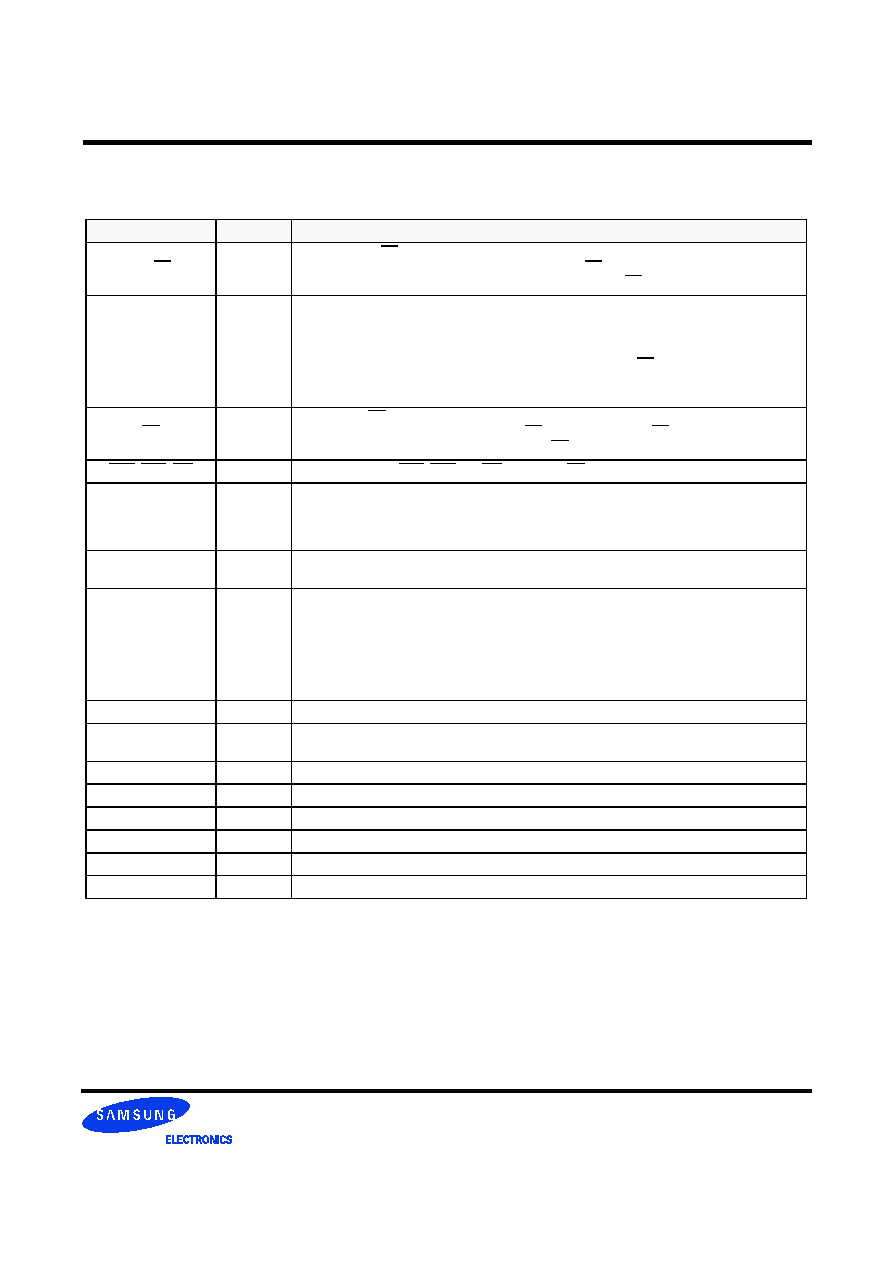
DDR SDRAM
DDR SDRAM 256Mb E-die (x4, x8)
Rev. 1.1 September. 2003
SYMBOL
TYPE
DESCRIPTION
CK, CK
Input
Clock : CK and CK are differential clock inputs. All address and control input signals are sam-
pled on the positive edge of CK and negative edge of CK. Output (read) data is referenced to
both edges of CK. Internal clock signals are derived from CK/CK.
CKE
Input
Clock Enable : CKE HIGH activates, and CKE LOW deactivates internal clock signals, and
device input buffers and output drivers. Deactivating the clock provides PRECHARGE
POWER-DOWN and SELF REFRESH operation (all banks idle), or ACTIVE POWER-DOWN
(row ACTIVE in any bank). CKE is synchronous for all functions except for disabling outputs,
which is achieved asynchronously. Input buffers, excluding CK, CK and CKE are disabled dur-
ing power-down and self refresh modes, providing low standby power. CKE will recognize an
LVCMOS LOW level prior to VREF being stable on power-up.
CS
Input
Chip Select : CS enables(registered LOW) and disables(registered HIGH) the command
decoder. All commands are masked when CS is registered HIGH. CS provides for external
bank selection on systems with multiple banks. CS is considered part of the command code.
RAS, CAS, WE
Input
Command Inputs : RAS, CAS and WE (along with CS) define the command being entered.
DM
Input
Input Data Mask : DM is an input mask signal for write data. Input data is masked when DM is
sampled HIGH along with that input data during a WRITE access. DM is sampled on both
edges of DQS. Although DM pins are input only, the DM loading matches the DQ and DQS
loading. DM may be driven high, low, or floating during READs.
BA0, BA1
Input
Bank Addres Inputs : BA0 and BA1 define to which bank an ACTIVE, READ, WRITE or PRE-
CHARGE command is being applied.
A [0 : 12]
Input
Address Inputs : Provide the row address for ACTIVE commands, and the column address and
AUTO PRECHARGE bit for READ/WRITE commands, to select one location out of the mem-
ory array in the respective bank. A10 is sampled during a PRECHARGE command to deter-
mine whether the PRECHARGE applies to one bank (A10 LOW) or all banks (A10 HIGH). If
only one bank is to be precharged, the bank is selected by BA0, BA1. The address inputs also
provide the op-code during a MODE REGISTER SET command. BA0 and BA1 define which
mode register is loaded during the MODE REGISTER SET command (MRS or EMRS).
DQ
I/O
Data Input/Output : Data bus
DQS
I/O
Data Strobe : Output with read data, input with write data. Edge-aligned with read data, cen-
tered in write data. Used to capture write data.
NC
-
No Connect : No internal electrical connection is present.
VDDQ
Supply
DQ Power Supply : +2.6V
±
0.1V.
VSSQ
Supply
DQ Ground.
VDD
Supply
Power Supply : +2.6V
±
0.1V (device specific).
VSS
Supply
Ground.
VREF
Input
SSTL_2 reference voltage.
Input/Output Function Description
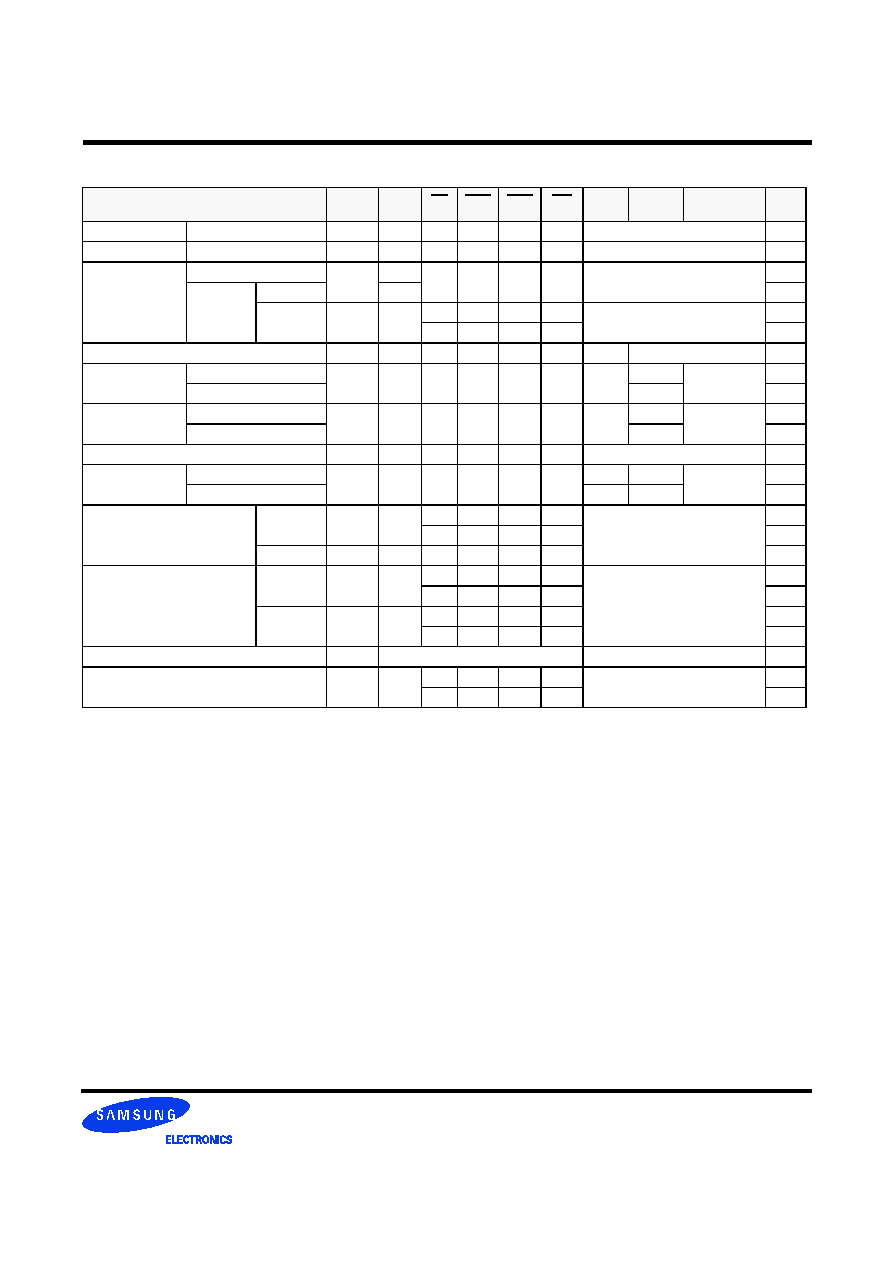
DDR SDRAM
DDR SDRAM 256Mb E-die (x4, x8)
Rev. 1.1 September. 2003
Command Truth Table
(V=Valid, X=Don
t Care, H=Logic High, L=Logic Low)
COMMAND
CKEn-1 CKEn
CS
RAS
CAS
WE
BA0,1 A10/AP
A0 ~ A9,
A11,A12
Note
Register
Extended MRS
H
X
L
L
L
L
OP CODE
1, 2
Register
Mode Register Set
H
X
L
L
L
L
OP CODE
1, 2
Refresh
Auto Refresh
H
H
L
L
L
H
X
3
Self
Refresh
Entry
L
3
Exit
L
H
L
H
H
H
X
3
H
X
X
X
3
Bank Active & Row Addr.
H
X
L
L
H
H
V
Row Address
Read &
Column Address
Auto Precharge Disable
H
X
L
H
L
H
V
L
Column
Address
4
Auto Precharge Enable
H
4
Write &
Column Address
Auto Precharge Disable
H
X
L
H
L
L
V
L
Column
Address
4
Auto Precharge Enable
H
4, 6
Burst Stop
H
X
L
H
H
L
X
7
Precharge
Bank Selection
H
X
L
L
H
L
V
L
X
All Banks
X
H
5
Active Power Down
Entry
H
L
H
X
X
X
X
L
V
V
V
Exit
L
H
X
X
X
X
Precharge Power Down Mode
Entry
H
L
H
X
X
X
X
L
H
H
H
Exit
L
H
H
X
X
X
L
V
V
V
DM(UDM/LDM for x16 only)
H
X
X
8
No operation (NOP) : Not defined
H
X
H
X
X
X
X
9
L
H
H
H
9
1. OP Code : Operand Code. A
0
~ A
12
& BA
0
~ BA
1
: Program keys. (@EMRS/MRS)
2. EMRS/MRS can be issued only at all banks precharge state.
A new command can be issued 2 clock cycles after EMRS or MRS.
3. Auto refresh functions are same as the CBR refresh of DRAM.
The automatical precharge without row precharge command is meant by "Auto".
Auto/self refresh can be issued only at all banks precharge state.
4. BA
0
~ BA
1
: Bank select addresses.
If both BA
0
and BA
1
are "Low" at read, write, row active and precharge, bank A is selected.
If BA
0
is "High" and BA
1
is "Low" at read, write, row active and precharge, bank B is selected.
If BA
0
is "Low" and BA
1
is "High" at read, write, row active and precharge, bank C is selected.
If both BA
0
and BA
1
are "High" at read, write, row active and precharge, bank D is selected.
5. If A
10
/AP is "High" at row precharge, BA
0
and BA
1
are ignored and all banks are selected.
6. During burst write with auto precharge, new read/write command can not be issued.
Another bank read/write command can be issued after the end of burst.
New row active of the associated bank can be issued at t
RP
after the end of burst.
7. Burst stop command is valid at every burst length.
8. DM(x4/8) sampled at the rising and falling edges of the DQS and Data-in are masked at the both edges (Write DM latency is 0).
DM sampled at the rising and falling edges of the DQS and Data-in are masked at the both edges
(Write DM latency is 0).
9. This combination is not defined for any function, which means "No Operation(NOP)" in DDR SDRAM.
Note :

DDR SDRAM
DDR SDRAM 256Mb E-die (x4, x8)
Rev. 1.1 September. 2003
16M x 4Bit x 4 Banks / 8M x 8Bit x 4 Banks Banks Double Data Rate SDRAM
The K4H560438E / K4H560838E / is 268,435,456 bits of double data rate synchronous DRAM organized as 4x 16,785,216 / 4x
8,388,608 words by 4/ 8bits, fabricated with SAMSUNG
s high performance CMOS technology. Synchronous features with Data Strobe
allow extremely high performance up to 333Mb/s per pin. I/O transactions are possible on both edges of DQS. Range of operating fre-
quencies, programmable burst length and programmable latencies allow the device to be useful for a variety of high performance mem-
ory system applications.
General Description
Absolute Maximum Rating
Parameter
Symbol
Value
Unit
Voltage on any pin relative to V
SS
V
IN
, V
OUT
-0.5 ~ 3.6
V
Voltage on V
DD
& V
DDQ
supply relative to V
SS
V
DD
, V
DDQ
-1.0 ~ 3.6
V
Storage temperature
T
STG
-55 ~ +150
∞
C
Power dissipation
P
D
1.5
W
Short circuit current
I
OS
50
mA
Note : Permanent device damage may occur if ABSOLUTE MAXIMUM RATINGS are exceeded.
Functional operation should be restricted to recommend operation condition.
Exposure to higher than recommended voltage for extended periods of time could affect device reliability.
DC Operating Conditions
Recommended operating conditions(Voltage referenced to V
SS
=0V, T
A
=0 to 70
∞
C)
Parameter
Symbol
Min
Max
Unit
Note
Supply voltage(for device with a nominal V
DD
of 2.5V)
V
DD
2.5
2.7
I/O Supply voltage
V
DDQ
2.5
2.7
V
I/O Reference voltage
V
REF
0.49*VDDQ
0.51*VDDQ
V
1
I/O Termination voltage(system)
V
TT
V
REF
-0.04
V
REF
+0.04
V
2
Input logic high voltage
V
IH
(DC)
V
REF
+0.15
V
DDQ
+0.3
V
Input logic low voltage
V
IL
(DC)
-0.3
V
REF
-0.15
V
Input Voltage Level, CK and CK inputs
V
IN
(DC)
-0.3
V
DDQ
+0.3
V
Input Differential Voltage, CK and CK inputs
V
ID
(DC)
0.36
V
DDQ
+0.6
V
3
V-I Matching: Pullup to Pulldown Current Ratio
VI(Ratio)
0.71
1.4
-
4
Input leakage current
I
I
-2
2
uA
Output leakage current
I
OZ
-5
5
uA
Output High Current(Normal strengh driver) ;V
OUT
= V
TT
+ 0.84V
I
OH
-16.8
mA
Output High Current(Normal strengh driver) ;V
OUT
= V
TT
- 0.84V
I
OL
16.8
mA
Output High Current(Half strengh driver) ;V
OUT
= V
TT
+ 0.45V
I
OH
-9
mA
Output High Current(Half strengh driver) ;V
OUT
= V
TT
- 0.45V
I
OL
9
mA
1.VREF is expected to be equal to 0.5*VDDQ of the transmitting device, and to track variations in the dc level of same.
Peak-to peak noise on VREF may not exceed +/-2% of the dc value.
2. V
TT
is not applied directly to the device. V
TT
is a system supply for signal termination resistors, is expected to be set equal to
V
REF
, and must track variations in the DC level of V
REF
3. V
ID
is the magnitude of the difference between the input level on CK and the input level on CK.
4. The ratio of the pullup current to the pulldown current is specified for the same temperature and voltage, over the entire
temperature and voltage range, for device drain to source voltages from 0.25V to 1.0V. For a given output, it represents the
maximum difference between pullup and pulldown drivers due to process variation. The full variation in the ratio of the
maximum to minimum pullup and pulldown current will not exceed 1/7 for device drain to source voltages from 0.1 to 1.0.
Note :
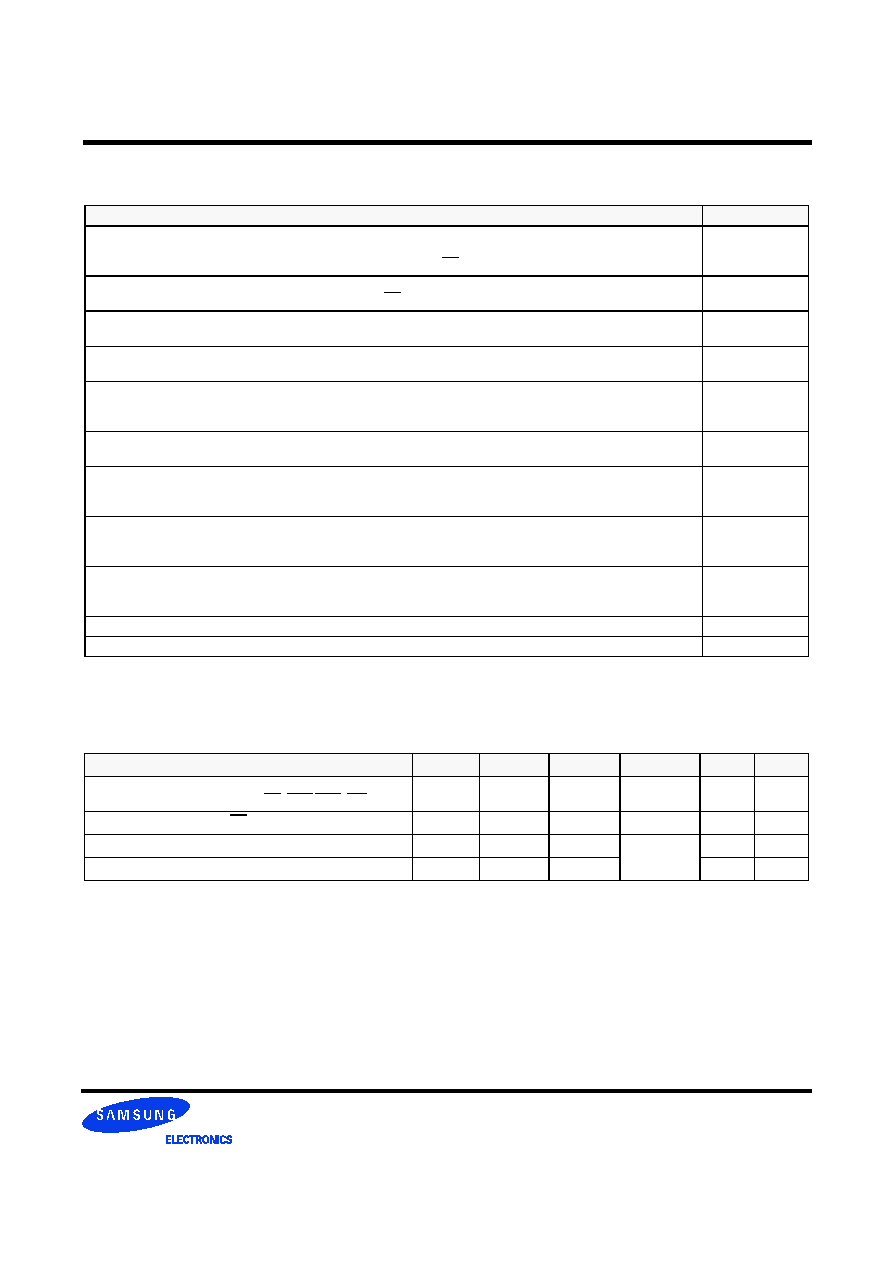
DDR SDRAM
DDR SDRAM 256Mb E-die (x4, x8)
Rev. 1.1 September. 2003
Input/Output Capacitance
(V
DD
=2.6, V
DDQ
=2.6V, T
A
= 25
∞
C, f=1MHz)
Parameter
Symbol
Min
Max
Delta
Unit
Note
Input capacitance
(A0 ~ A12, BA0 ~ BA1, CKE, CS, RAS,CAS, WE)
CIN1
1.5
2.5
0.5
pF
4
Input capacitance( CK, CK )
CIN2
1.5
2.5
0.25
pF
4
Data & DQS input/output capacitance
COUT
3.5
4.5
0.5
pF
1,2,3,4
Input capacitance (DM)
CIN3
3.5
4.5
pF
1,2,3,4
Note : 1.These values are guaranteed by design and are tested on a sample basis only.
2. Although DM is an input -only pin, the input capacitance of this pin must model the input capacitance of the DQ and DQS pins.
This is required to match signal propagation times of DQ, DQS, and DM in the system.
3. Unused pins are tied to ground.
4. This parameteer is sampled. VDDQ = +2.6V +0.1V, VDD = +2.6V +0.1V, f=100MHz, tA=25
∞
C, Vout(dc) =
VDDQ/2, Vout(peak to peak) = 0.2V. DM inputs are grouped with I/O pins - reflecting the fact that they are matched in loading
(to facilitate trace matching at the board level).
DDR SDRAM Spec Items & Test Conditions
Conditions
Symbol
Operating current - One bank Active-Precharge;
tRC=tRCmin; tCK=5ns for DDR400; DQ,DM and DQS inputs changing once per clock cycle;
address and control inputs changing once every two clock cycles; CS = high between valid commands.
IDD0
Operating current - One bank operation ; One bank open, BL=4, Reads
- Refer to the following page for detailed test condition; CS = high between valid commands.
IDD1
Percharge power-down standby current; All banks idle; power - down mode; CKE = <VIL(max); tCK=5ns for
DDR400; Vin = Vref for DQ,DQS and DM.
IDD2P
Precharge Floating standby current; CS# > =VIH(min);All banks idle; CKE > = VIH(min); tCK=5ns for DDR400;
Address and other control inputs changing once per clock cycle; Vin = Vref for DQ,DQS and DM
IDD2F
Precharge Quiet standby current; CS# > = VIH(min); All banks idle;
CKE > = VIH(min); tCK=5ns for DDR400; Address and other control inputs stable at >= VIH(min) or =<VIL(max);
Vin = Vref for DQ ,DQS and DM
IDD2Q
Active power - down standby current ; one bank active; power-down mode; CKE=< VIL (max); tCK=5ns
DDR400; Vin = Vref for DQ,DQS and DM
IDD3P
Active standby current; CS# >= VIH(min); CKE>=VIH(min);
one bank active; active - precharge; tRC=tRASmax; tCK=5ns for DDR400; DQ, DQS and DM inputs changing twice
per clock cycle; address and other control inputs changing once per clock cycle
IDD3N
Operating current - burst read; Burst length = 2; reads; continguous burst; One bank active; address and control
inputs changing once per clock cycle; CL=3 at 5ns for DDR400; 50% of data changing on every transfer; lout = 0 m
A
IDD4R
Operating current - burst write; Burst length = 2; writes; continuous burst;
One bank active address and control inputs changing once per clock cycle; CL=3 at tCK=5ns for DDR400; DQ, DM
and DQS inputs changing twice per clock cycle, 50% of input data changing at every transfer
IDD4W
Auto refresh current; tRC = tRFC(min) - 14*tCK for DDR400 at tCK=5ns;
IDD5
Self refresh current; CKE =< 0.2V; External clock on; tCK = 5ns for DDR400.
IDD6

DDR SDRAM
DDR SDRAM 256Mb E-die (x4, x8)
Rev. 1.1 September. 2003
DDR SDRAM I
DD
spec table
(V
DD
=2.7V, T = 10
∞
C)
Symbol
64Mx4 (K4H560438E), 32Mx8 (K4H560838E)
Unit
Notes
CC(DDR400@CL=3)
C4(DDR400@CL=3)
IDD0
105
100
mA
IDD1
130
130
mA
IDD2P
4
4
mA
IDD2F
30
30
mA
IDD2Q
25
25
mA
IDD3P
55
55
mA
IDD3N
75
75
mA
IDD4R
185
185
mA
IDD4W
190
190
mA
IDD5
180
180
mA
IDD6
Normal
3
3
mA
Low power
1.5
1.5
mA
Optional
IDD7A
310
290
mA
< Detailed test conditions for DDR SDRAM IDD1 & IDD7A >
IDD1 : Operating current: One bank operation
1. Only one bank is accessed with tRC(min), Burst Mode, Address and Control inputs change logic state once per Deselect cycle.
Iout = 0mA
2. Timing patterns
- CC/C4(200Mhz,CL=3) : tCK=5ns, CL=3, BL=4, tRCD=3*tCK(CC) 4*tCK(C4), tRC=11*tCK(CC) 12*tCK(C4), tRAS=8*tCK
Setup : A0 N N R0 N N N N P0 N N
Read : A0 N N R0 N N N N P0 N N - repeat the same timing with random address changing
*50% of data changing at every transfer
IDD7A : Operating current: Four bank operation
1. Four banks are being interleaved with tRC(min), Burst Mode, Address and Control inputs on Deselet edge are not changing.
Iout = 1mA
2. Timing patterns
- CC/C4(200Mhz,CL=3) : tCK=5ns, CL=3, BL=4, tRCD=3*tCK(CC) 4*tCK(C4), tRC=11*tCK(CC) 12*tCK(C4), tRAS=8*tCK
Setup : A0 N A1 RA0 A2 RA1 A3 RA2 N RA3 N N
Read : A0 N A1 RA0 A2 RA1 A3 RA2 N RA3 N N - repeat the same timing with random address changing
*50% of data changing at every transfer
Legend : A = Activate, R=Read, W=Write, P=Precharge, N=NOP
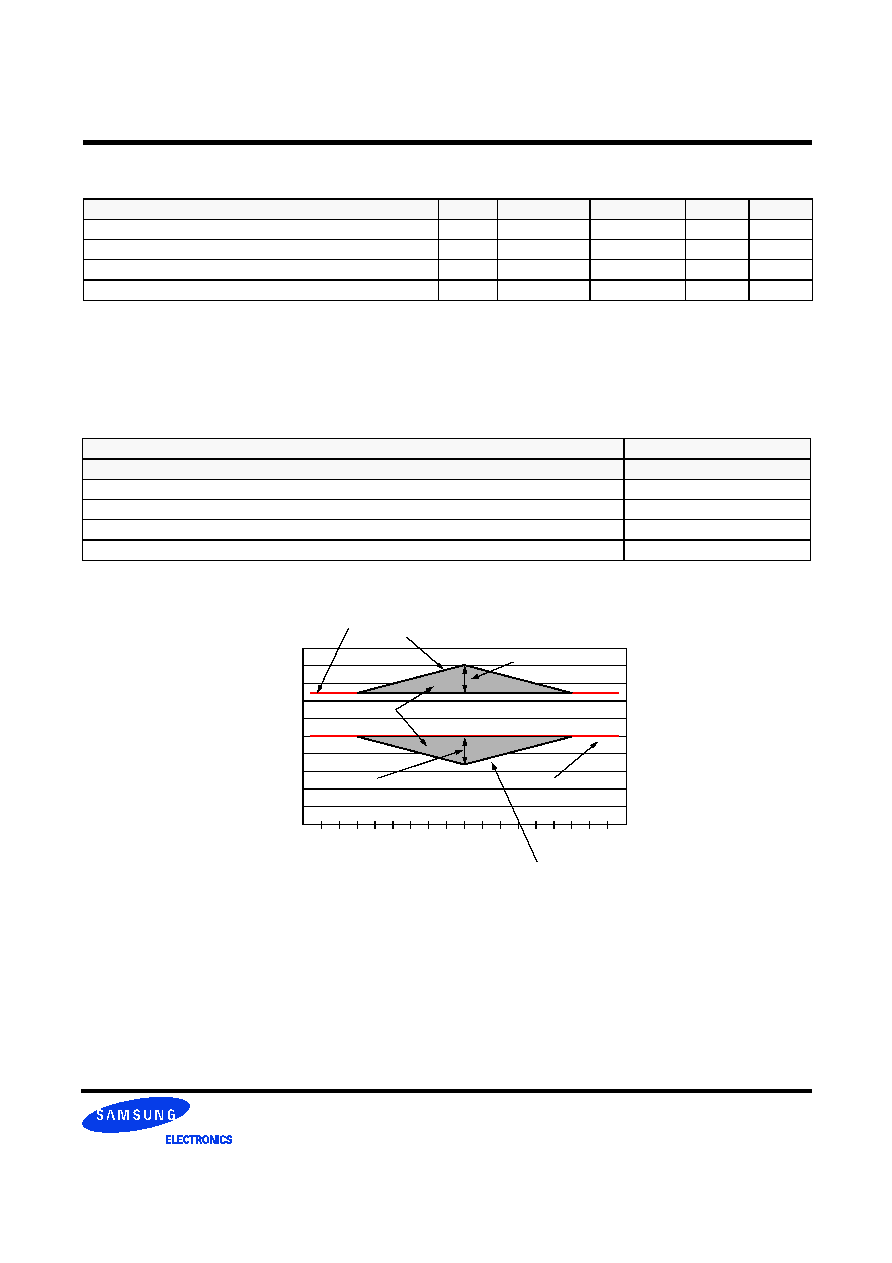
DDR SDRAM
DDR SDRAM 256Mb E-die (x4, x8)
Rev. 1.1 September. 2003
AC Operating Conditions
Parameter/Condition
Symbol
Min
Max-10
Unit
Note
Input High (Logic 1) Voltage, DQ, DQS and DM signals
VIH(AC)
VREF + 0.31
V
Input Low (Logic 0) Voltage, DQ, DQS and DM signals.
VIL(AC)
VREF - 0.31
V
Input Differential Voltage, CK and /CK inputs
VID(AC)
0.7
VDDQ+0.6
V
1
Input Crossing Point Voltage, CK and /CK inputs
VIX(AC)
0.5*VDDQ-0.2
0.5*VDDQ+0.2
V
2
5
4
3
2
1
0
-1
-2
-3
-4
-5
0
0.5
0.6875
1.0
1.5
2.0
2.5
3.0
3.5
4.0
4.5
5.0
5.5
6.0
6.3125
6.5
7.0
VDD
Overshoot
Maximum Amplitude = 1.5V
Area = 4.5V-ns
Maximum Amplitude = 1.5V
undershoot
GND
Vo
l
t
s
(
V
)
Tims(ns)
AC overshoot/Undershoot Definition
Notes :
1. VID is the magnitude of the difference between the input level on CK and the input level on /CK.
2. The value of VIX is expected to equal 0.5*VDDQ of the transmitting device and must track variations in the dc level of the same.
AC Overshoot/Undershoot specification for Address and Control Pins
Parameter
Specification
DDR400
Maximum peak amplitude allowed for overshoot
1.5V
Maximum peak amplitude allowed for undershoot
1.5V
The area between the overshoot signal and VDD must be less than or equal to
4.5V-ns
The area between the undershoot signal and GND must be less than or equal to
4.5V-ns

DDR SDRAM
DDR SDRAM 256Mb E-die (x4, x8)
Rev. 1.1 September. 2003
5
4
3
2
1
0
-1
-2
-3
-4
-5
0 0.5 1.0 1.42 1.5 2.0 2.5 3.0 3.5 4.0 4.5 5.0 5.5 5.68 6.0 6.5 7.0
VDDQ
Overshoot
Maximum Amplitude = 1.2V
Area = 2.4V-ns
Maximum Amplitude = 1.2V
undershoot
GND
Vo
l
t
s
(
V
)
Tims(ns)
DQ/DM/DQS AC overshoot/Undershoot Definition
Overshoot/Undershoot specification for Data, Strobe, and Mask Pins
Parameter
Specification
DDR400
Maximum peak amplitude allowed for overshoot
1.2V
Maximum peak amplitude allowed for undershoot
1.2V
The area between the overshoot signal and VDD must be less than or equal to
2.5V-ns
The area between the undershoot signal and GND must be less than or equal to
2.5V-ns
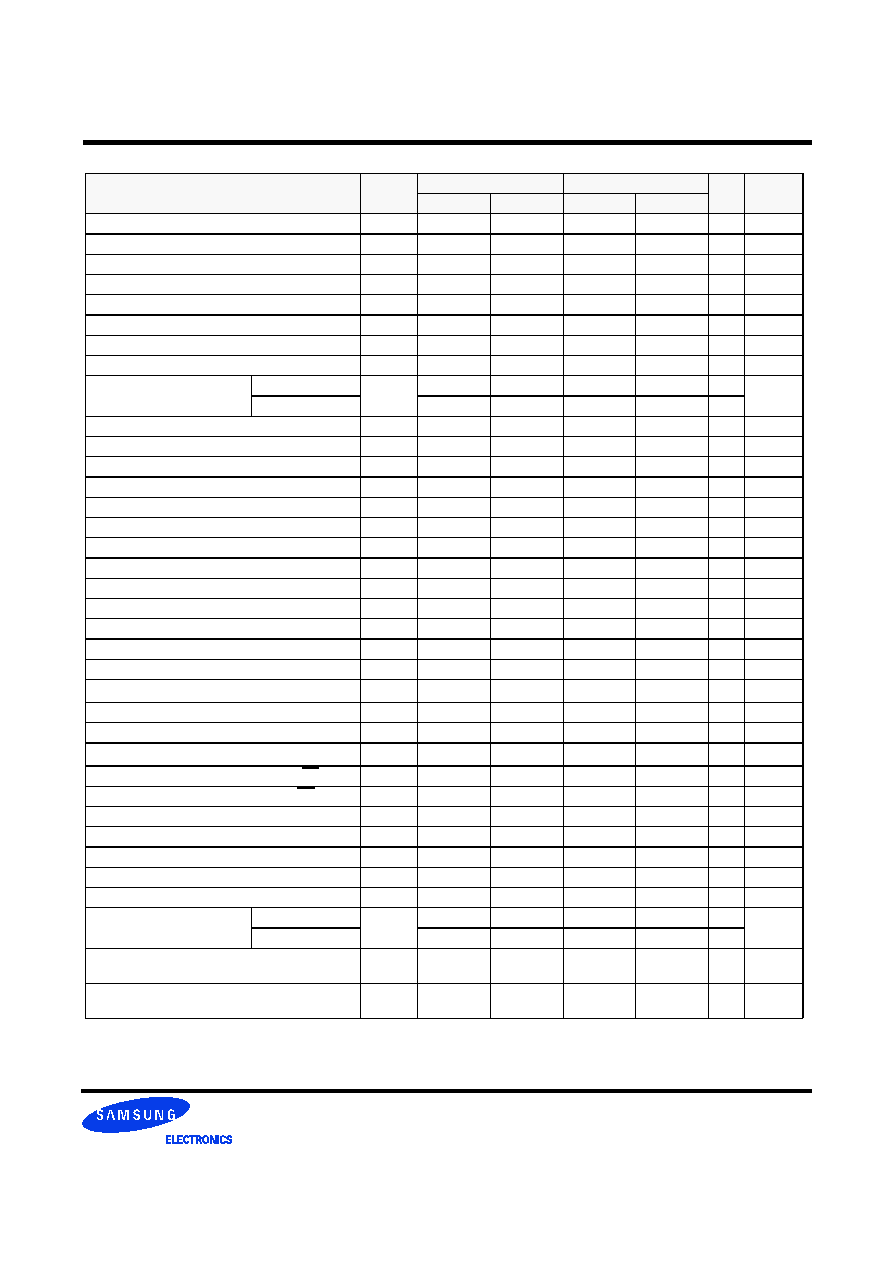
DDR SDRAM
DDR SDRAM 256Mb E-die (x4, x8)
Rev. 1.1 September. 2003
AC Timing Parameters and Specifications
Parameter
Symbol
- CC(DDR400@CL=3)
- C4(DDR400@CL=3)
Unit
Note
Min
Max
Min
Max
Row cycle time
tRC
55
60
ns
Refresh row cycle time
tRFC
70
70
ns
Row active time
tRAS
40
70K
40
70K
ns
RAS to CAS delay
tRCD
15
18
ns
Row precharge time
tRP
15
18
ns
Row active to Row active delay
tRRD
10
10
ns
Write recovery time
tWR
15
15
ns
Internal write to read command delay
tWTR
2
2
tCK
Clock cycle time
CL=3.0
tCK
5
10
5
10
ns
16
CL=2.5
6
12
6
12
ns
Clock high level width
tCH
0.45
0.55
0.45
0.55
tCK
Clock low level width
tCL
0.45
0.55
0.45
0.55
tCK
DQS-out access time from CK/CK
tDQSCK
-0.55
+0.55
-0.55
+0.55
ns
Output data access time from CK/CK
tAC
-0.65
+0.65
-0.65
+0.65
ns
Data strobe edge to ouput data edge
tDQSQ
-
0.4
-
0.4
ns
13
Read Preamble
tRPRE
0.9
1.1
0.9
1.1
tCK
Read Postamble
tRPST
0.4
0.6
0.4
0.6
tCK
CK to valid DQS-in
tDQSS
0.72
1.28
0.72
1.28
tCK
Write preamble setup time
tWPRES
0
0
ps
5
Write preamble
tWPRE
0.25
0.25
tCK
Write postamble
tWPST
0.4
0.6
0.4
0.6
tCK
4
DQS falling edge to CK rising-setup time
tDSS
0.2
0.2
tCK
DQS falling edge from CK rising-hold time
tDSH
0.2
0.2
tCK
DQS-in high level width
tDQSH
0.35
0.35
tCK
DQS-in low level width
tDQSL
0.35
0.35
tCK
Address and Control Input setup time
tIS
0.6
0.6
ns
h,7~10
Address and Control Input hold time
tIH
0.6
0.6
ns
h,7~10
Data-out high impedence time from CK/CK
tHZ
-
tAC max
-
tAC max
ns
3
Data-out low impedence time from CK/CK
tLZ
tAC min
tAC max
tAC min
tAC max
ns
3
Mode register set cycle time
tMRD
2
2
tCK
DQ & DM setup time to DQS, slew rate 0.5V/ns
tDS
0.4
0.4
ns
i, j
DQ & DM hold time to DQS, slew rate 0.5V/ns
tDH
0.4
0.4
ns
i, j
DQ & DM input pulse width
tDIPW
1.75
1.75
ns
9
Control & Address input pulse width for each input
tIPW
2.2
2.2
ns
9
Refresh interval time
Up to 128Mb
tREFI
15.6
15.6
us
6
256Mb, 512Mb, 1Gb
7.8
7.8
us
Output DQS valid window
tQH
tHP
-tQHS
-
tHP
-tQHS
-
ns
12
Clock half period
tHP
min
tCH/tCL
-
min
tCH/tCL
-
ns
11, 12
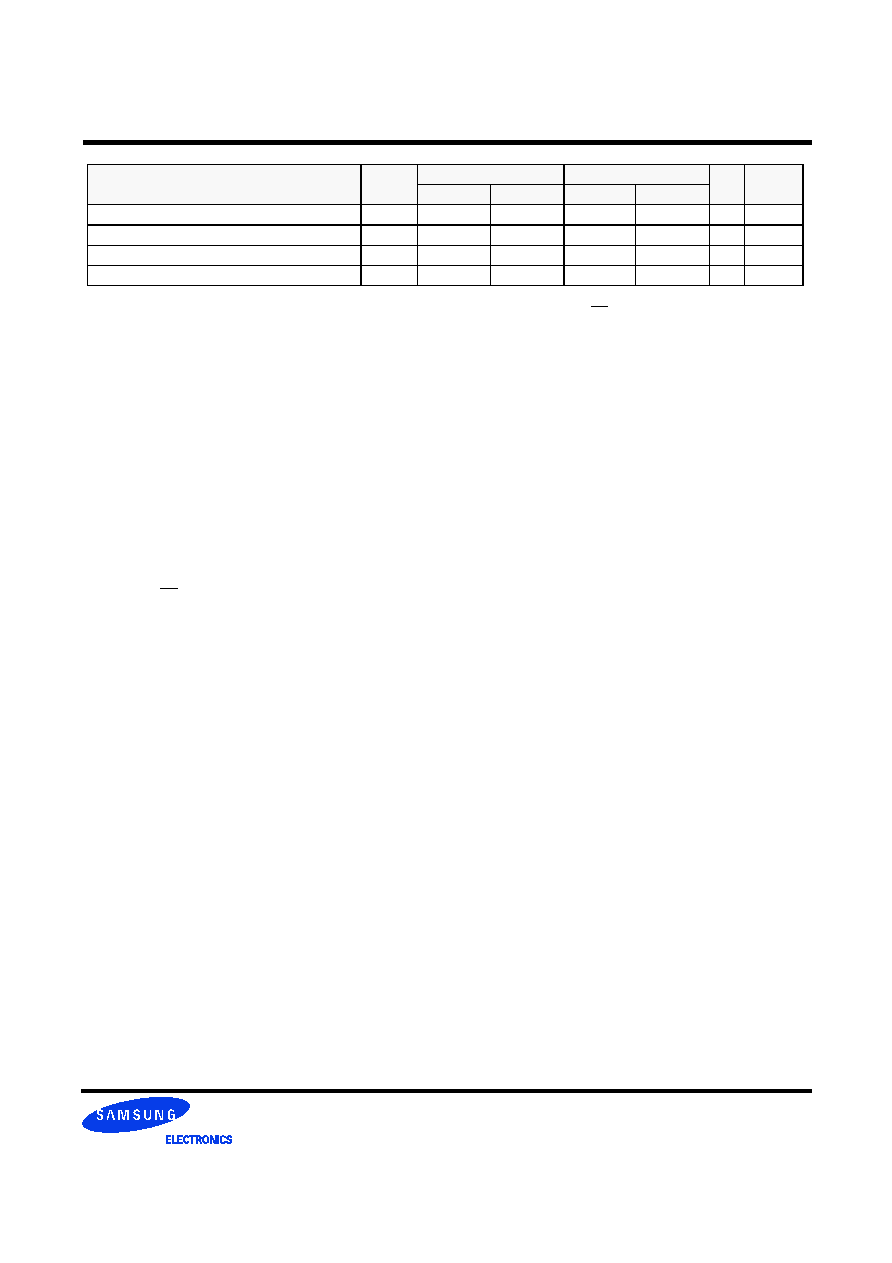
DDR SDRAM
DDR SDRAM 256Mb E-die (x4, x8)
Rev. 1.1 September. 2003
Component Notes
1.V
ID
is the magnitude of the difference between the input level on CK and the input level on CK.
2. The value of VIX is expected to equal 0.5*VDDQ of the transmitting device and must track variations in the dc level of the same.
3. tHZ and tLZ transitions occur in the same access time windows as valid data transitions. these parameters are not referenced to a
specific voltage level but specify when the device output in no longer driving (HZ), or begins driving (LZ).
4. The maximum limit for this parameter is not a device limit. The device will operate with a greater value for this parameter, but sys
tem performance (bus turnaround) will degrade accordingly.
5. The specific requirement is that DQS be valid (HIGH, LOW, or at some point on a valid transition) on or before this CK edge. A
valid transition is defined as monotonic and meeting the input slew rate specifications of the device. when no writes were previ
ously in progress on the bus, DQS will be tran sitioning from High- Z to logic LOW. If a previous write was in progress, DQS could
be HIGH, LOW, or transitioning from HIGH to LOW at this time, depending on tDQSS.
6. A maximum of eight AUTO REFRESH commands can be posted to any given DDR SDRAM device.
7. For command/address input slew rate
0.5 V/ns
8. For CK & CK slew rate
0.5 V/ns
9. These parameters guarantee device timing, but they are not necessarily tested on each device. They may be guaranteed by
device design or tester correlation.
10. Slew Rate is measured between VOH(ac) and VOL(ac).
11. Min (tCL, tCH) refers to the smaller of the actual clock low time and the actual clock high time as provided to the device (i.e. this
value can be greater than the minimum specification limits for tCL and tCH).....For example, tCL and tCH are = 50% of the
period, less the half period jitter (tJIT(HP)) of the clock source, and less the half period jitter due to crosstalk (tJIT(crosstalk)) into
the clock traces.
12. tQH = tHP - tQHS, where:
tHP = minimum half clock period for any given cycle and is defined by clock high or clock low (tCH, tCL). tQHS accounts for 1) The
pulse duration distortion of on-chip clock circuits; and 2) The worst case push-out of DQS on one tansition followed by the worst
case pull-in of DQ on the next transition, both of which are, separately, due to data pin skew and output pattern effects, and p-
channel to n-channel variation of the output drivers.
13. tDQSQ
Consists of data pin skew and output pattern effects, and p-channel to n-channel variation of the output drivers for any given
cycle.
14. tDAL = (tWR/tCK) + (tRP/tCK)
For each of the terms above, if not already an integer, round to the next highest integer. Example: For DDR400(CC) at CL=3 and
tCK=5ns tDAL = (15 ns / 5 ns) + (15 ns/ 5ns) = {(3) + (3)}CLK
tDAL = 6 clocks
15. In all circumstances, tXSNR can be satisfied using tXSNR=tRFCmin+1*tCK
16. The only time that the clock frequency is allowed to change is during self-refresh mode.
Parameter
Symbol
- CC(DDR400@CL=3)
- C4(DDR400@CL=3)
Unit
Note
Min
Max
Min
Max
Data hold skew factor
tQHS
0.5
0.5
ns
12
Auto Precharge write recovery + precharge time
tDAL
-
-
-
-
ns
14
Exit self refresh to non-READ command
tXSNR
75
75
ns
15
Exit self refresh to READ command
tXSRD
200
-
200
-
tCK
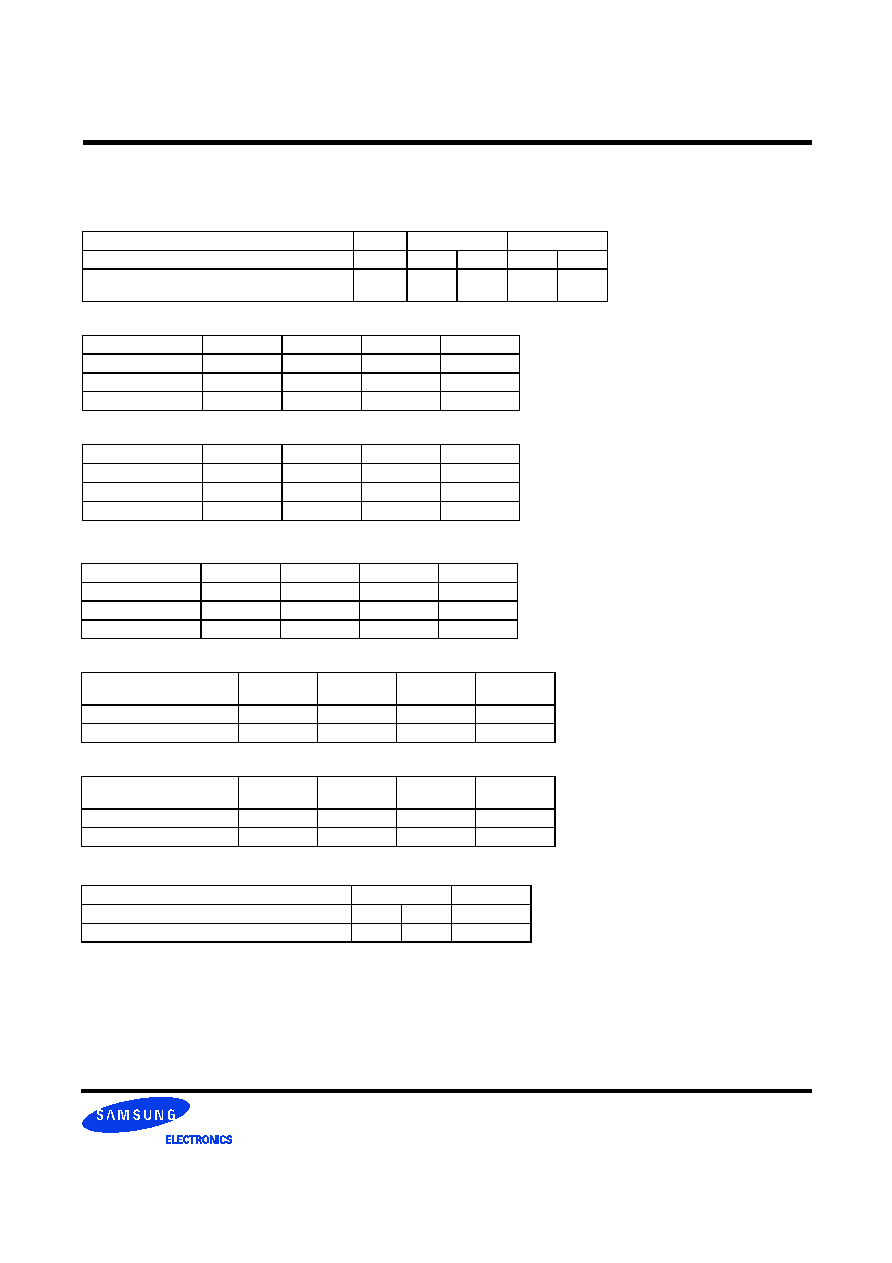
DDR SDRAM
DDR SDRAM 256Mb E-die (x4, x8)
Rev. 1.1 September. 2003
Table 4 : Input/Output Setup & Hold Derating for Rise/Fall Delta Slew Rate
Table 5 : Output Slew Rate Characteristice (X8 Devices only)
Table 6 : Output Slew Rate Characteristice (X16 Devices only)
Table 7 : Output Slew Rate Matching Ratio Characteristics
Delta Slew Rate
tDS
tDH
Units
Notes
+/- 0.0 V/ns
0
0
ps
i
+/- 0.25 V/ns
+50
+50
ps
i
+/- 0.5 V/ns
+100
+100
ps
i
Slew Rate Characteristic
Typical Range
(V/ns)
Minimum
(V/ns)
Maximum
(V/ns)
Notes
Pullup Slew Rate
1.2 ~ 2.5
1.0
4.5
a,c,d,f,g
Pulldown slew
1.2 ~ 2.5
1.0
4.5
b,c,d,f,g
Slew Rate Characteristic
Typical Range
(V/ns)
Minimum
(V/ns)
Maximum
(V/ns)
Notes
Pullup Slew Rate
1.2 ~ 2.5
0.7
5.0
a,c,d,f,g
Pulldown slew
1.2 ~ 2.5
0.7
5.0
b,c,d,f,g
AC CHARACTERISTICS
DDR400
PARAMETER
MIN
MAX
Notes
Output Slew Rate Matching Ratio (Pullup to Pulldown)
-
-
e,k
System Characteristics for DDR SDRAM
The following specification parameters are required in systems using DDR400 devices to ensure proper system perfor-
mance. these characteristics are for system simulation purposes and are guaranteed by design.
Table 1 : Input Slew Rate for DQ, DQS, and DM
Table 2 : Input Setup & Hold Time Derating for Slew Rate
Table 3 : Input/Output Setup & Hold Time Derating for Slew Rate
AC CHARACTERISTICS
DDR400
PARAMETER
SYMBOL
MIN
MAX
Units
Notes
DQ/DM/DQS input slew rate measured between
VIH(DC), VIL(DC) and VIL(DC), VIH(DC)
DCSLEW
0.5
4.0
V/ns
a, k
Input Slew Rate
tIS
tIH
Units
Notes
0.5 V/ns
0
0
ps
h
0.4 V/ns
+50
0
ps
h
0.3 V/ns
+100
0
ps
h
Input Slew Rate
tDS
tDH
Units
Notes
0.5 V/ns
0
0
ps
j
0.4 V/ns
+75
+75
ps
j
0.3 V/ns
+150
+150
ps
j
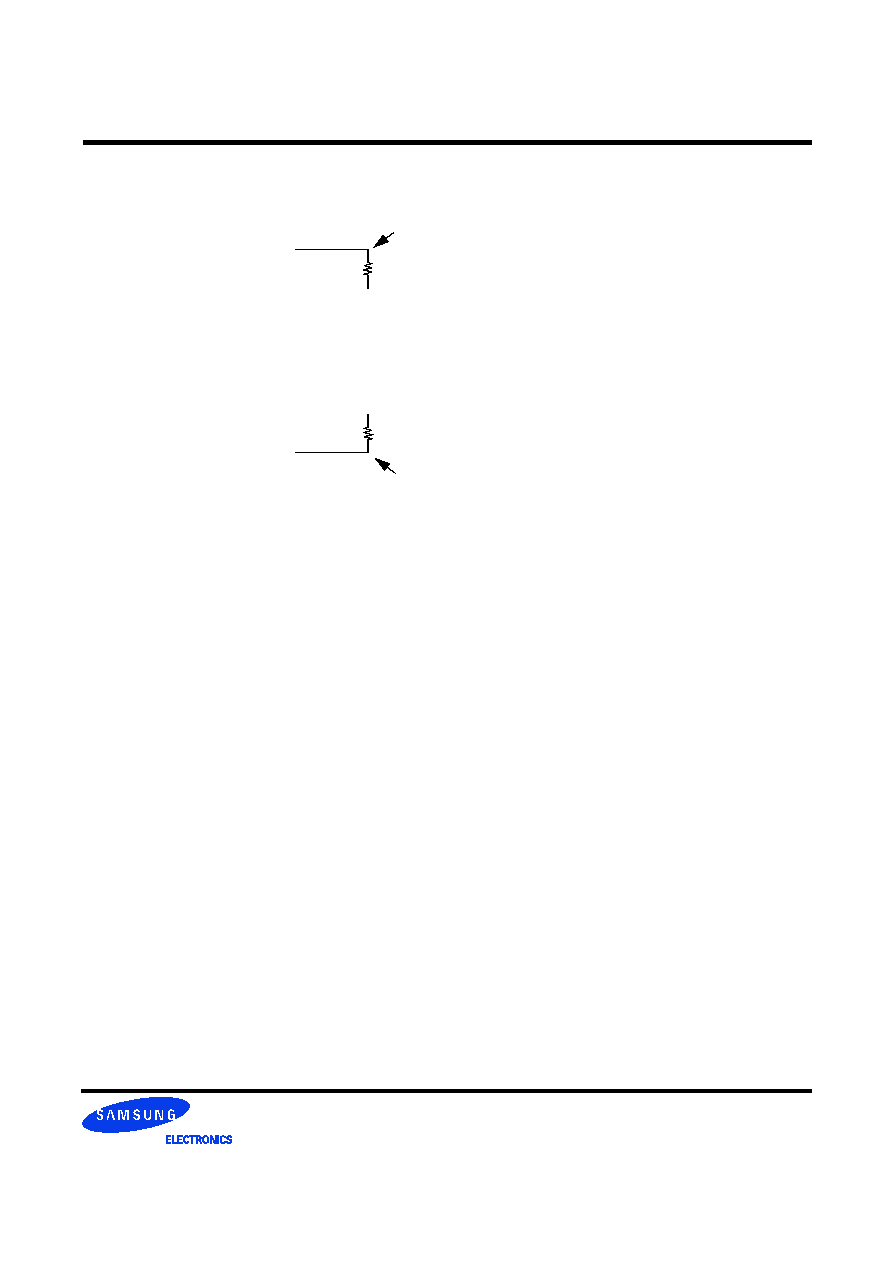
DDR SDRAM
DDR SDRAM 256Mb E-die (x4, x8)
Rev. 1.1 September. 2003
System Notes :
a. Pullup slew rate is characteristized under the test conditions as shown in Figure 1.
Output
Test point
VSSQ
50
Figure 1 : Pullup slew rate test load
b. Pulldown slew rate is measured under the test conditions shown in Figure 2.
Output
Test point
VDDQ
50
Figure 2 : Pulldown slew rate test load
c. Pullup slew rate is measured between (VDDQ/2 - 320 mV +/- 250 mV)
Pulldown slew rate is measured between (VDDQ/2 + 320 mV +/- 250 mV)
Pullup and Pulldown slew rate conditions are to be met for any pattern of data, including all outputs switching and only one output
switching.
Example : For typical slew rate, DQ0 is switching
For minmum slew rate, all DQ bits are switching from either high to low, or low to high.
For Maximum slew rate, only one DQ is switching from either high to low, or low to high.
The remaining DQ bits remain the same as for previous state.
d. Evaluation conditions
Typical : 25
∞
C (T Ambient), VDDQ = 2.6V, typical process
Minimum : 70
∞
C (T Ambient), VDDQ = 2.5V, slow - slow process
Maximum : 0
∞
C (T Ambient), VDDQ = 2.7V, fast - fast process
e. The ratio of pullup slew rate to pulldown slew rate is specified for the same temperature and voltage, over the entire temperature and
voltage range. For a given output, it represents the maximum difference between pullup and pulldown drivers due to process variation.
f. Verified under typical conditions for qualification purposes.
g. TSOPII package divices only.
h. A derating factor will be used to increase tIS and tIH in the case where the input slew rate is below 0.5V/ns
as shown in Table 2. The Input slew rate is based on the lesser of the slew rates detemined by either VIH(AC) to VIL(AC) or
VIH(DC) to VIL(DC), similarly for rising transitions.
i. A derating factor will be used to increase tDS and tDH in the case where DQ, DM, and DQS slew rates differ, as shown in Tables 3 & 4.
Input slew rate is based on the larger of AC-AC delta rise, fall rate and DC-DC delta rise, Input slew rate is based on the lesser of the
slew rates determined by either VIH(AC) to VIL(AC) or VIH(DC) to VIL(DC), similarly for rising transitions.
The delta rise/fall rate is calculated as:
{1/(Slew Rate1)} - {1/(Slew Rate2)}
For example : If Slew Rate 1 is 0.5 V/ns and slew Rate 2 is 0.4 V/ns, then the delta rise, fall rate is - 0.5ns/V . Using the table given, this
would result in the need for an increase in tDS and tDH of 100 ps.

DDR SDRAM
DDR SDRAM 256Mb E-die (x4, x8)
Rev. 1.1 September. 2003
j. Table 3 is used to increase tDS and tDH in the case where the I/O slew rate is below 0.5 V/ns. The I/O slew rate is based on the lesser
on the lesser of the AC - AC slew rate and the DC- DC slew rate. The inut slew rate is based on the lesser of the slew rates deter
mined by either VIH(ac) to VIL(ac) or VIH(DC) to VIL(DC), and similarly for rising transitions.
k. DQS, DM, and DQ input slew rate is specified to prevent double clocking of data and preserve setup and hold times. Signal transi
tions through the DC region must be monotony.

















